Many of the ‘built environment’ examples discussed here over the last year-and-a-bit have been intended to control (or “manage”) traffic in some way, e.g to slow drivers down, force them to take an alternative route, or force them to stop. I thought it would be worth mentioning a couple of other methods, the rationales behind them, and some of the problems:
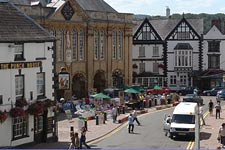
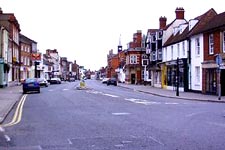
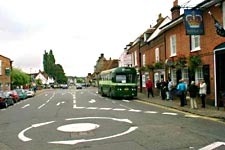
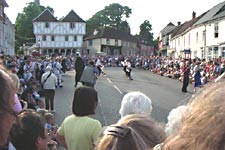
Top row: Monmouth, Monmouthshire and Thame, Oxfordshire; Bottom row: Amersham, Buckinghamshire and Thaxted, Essex. Images from the sites linked.
Historical example: market places
Mediæval market towns commonly had a wide market street, or square, with narrow entrances at the ends, to make it more difficult for animals to escape, and also easier to control when herding them in and out. It may not be immediately obvious from the above photos, but in each of these towns (as with many others where the old layout has been preserved), the market area was, and still is, laid out in this way. It may also have made it more difficult for a thief to escape, since with only a few exit ‘pinch points’, it would make him easier to spot.
This is, of course, almost the opposite rationale to Baron Haussmann’s Paris, with its wide, straight boulevards which prevented effective barricading by revolutionaries and allowed clear lines-of-sight to fire on them.
References: Thaxted at ‘Rural Roads’; History of Thame; Monmouth on Wikipedia.
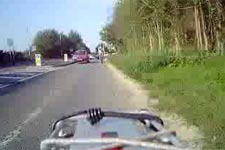
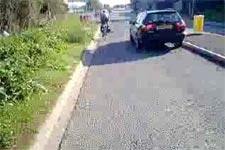
Stills from video clips of cars overtaking cyclists at pinch points, from the Cambridge Cycling Campaign website.
Pinch points and other road narrowings
In modern use, pinch points are often installed (along with centre hatching) to force drivers to slow down, usually in built-up areas or at the entrance to them, where there may also be a speed limit change. Sometimes they also force one stream of traffic to stop to allow the other priority, for example when crossing a narrow bridge. Sometimes there are built-out kerbs on both sides of the road; sometimes just a central island; sometimes all three. In general, they prevent drivers overtaking other cars by putting a physical obstruction in the way, even though otherwise it might be legal to overtake. (This is a built environment example of Lessig’s “Code is law” – regardless of what the law might permit or prohibit, it’s the way the system is coded which actually defines what behaviour is possible.)
The problem is that – something which as a driver and a cyclist (and bike designer) I experience a lot – the sudden narrowing of the carriageway causes (forces) drivers to move towards the nearside. And if there’s a cyclist on the nearside, even cycling close to the kerb, he or she will suddenly have a driver passing very close, braking very hard, possibly clipping the bike or actually hitting it. It’s even worse if the kerb is built out as well, since the cyclist has to swerve out into the path of the traffic which may also be swerving in to avoid a central island. In cities such as Cambridge with a lot of cyclists and a lot of traffic, the pinch points are a major problem.
A lot of injuries and deaths have been caused by this ‘safety’ measure. Someone very close to me was knocked off her bike and hurt after swerving onto the kerb to avoid a large truck bearing down on her as the driver tried to fit through a pinch point (similarly to the situation in the photo at the top of Howard Peel’s detailed assessment of pinch points at the Bike Zone). As with so many architectures of control, the designers of these layouts seem to view most users (both drivers and cyclists) as ‘enemies’ who need to be cajoled and coerced into behaving a certain way, without actually looking at what their needs are.
The North Somerset Cycle Campaign’s article on “Good and bad practice” with pinch points shows a far superior layout, for both drives and cyclists (photo reproduced below), from the Netherlands – cycles and cars are kept apart, neither cyclist nor driver is forced to deviate from his/her path, but drivers must give negotiate priority with their oncoming counterparts.

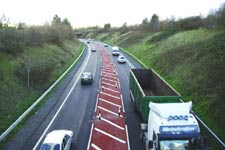
Left: A better pinch point implementation from the Netherlands – image from the North Somerset Cycle Campaign; Right: A very dangerous (and ridiculous) real-world example of hatching-with-obstacles from Devon – image from Richie Graham, discussed in this thread on SABRE
Looking further at centre hatching, this too often causes drivers to pass much too close when overtaking cyclists, since (in the UK), most drivers are reluctant to enter it to overtake even though (with broken lines along the side) they are legally entitled to do so. The reluctance may come from ignorance of the law, but in many cases it is often because there may suddenly be a central concrete island in the middle with no warning. (This is certainly why I’m very careful when using the hatched area to overtake.) Again, this is a de facto imposition of regulation without a legal mechanism enforcing it. As Peter Edwardson puts it:
Two reasons are normally advanced to justify hatched areas, neither of which is entirely convincing. The first is that they separate streams of traffic, but how many head-on collisions occur on single carriageway roads anyway, and surely in the vast majority of cases they involve a driver who has recklessly crossed the white line. The second is that they slow traffic down, which may be true to a limited extent, but again is of no value unless it reduces accidents at the same time…
However, I have recently seen a document from the Highways Agency… that stated clearly that one of the aims of hatched areas was to “deter overtaking”. They daren’t go so far as to actually ban it on straight stretches of road by painting double white lines (although no doubt that will come) but instead they put in confusing paint schemes that have the practical effect of doing just that.
There is of course one entirely sound and legitimate reason for painting hatched areas on the road, to provide a refuge for vehicles turning right, something that in the past has been a major factor in accidents. However such areas should only extend at most for a hundred yards or so on either side of the right turn, and should not be used as an excuse to paint a wide hatched area for a long distance.
In the case of the astonishing (to a UK driver’s eyes) implementation of hatching on the A39 (soon to be A361) Barnstaple southern bypass in Devon – the right-hand photo above – actual bollards have been embedded in the road surface to ‘enforce’ a de facto ‘no overtaking’ intention, though the hatching area actually makes it perfectly legal to overtake. (It makes it worse that the reflectors on the bollards are the wrong colour as well.) Motorcyclists could overtake by weaving between the bollards into the hatched area, but this wouldn’t be especially easy or safe. It would certainly be more dangerous than the alternative situation of wider lanes with no hatching and no bollards. So what’s the point of the scheme?
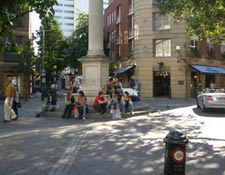
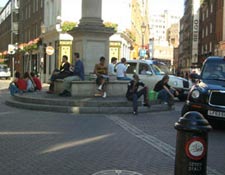
A Shared Space implementation at Seven Dials in central London, by Hamilton-Baillie Associates
Psychological techniques
We’ve looked before at ‘Shared Space’, ‘naked roads’ and other ‘psychological techniques’ to encourage drivers to be more alert, but Mike Morris sends me a link to this Spiegel story going into more detail and discussing Europe-wide pilot projects:
The utopia has already become a reality in Makkinga, in the Dutch province of Western Frisia. A sign by the entrance to the small town (population 1,000) reads “Verkeersbordvrij” — “free of traffic signs.” Cars bumble unhurriedly over precision-trimmed granite cobblestones. Stop signs and direction signs are nowhere to be seen. There are neither parking meters nor stopping restrictions. There aren’t even any lines painted on the streets.
“The many rules strip us of the most important thing: the ability to be considerate. We’re losing our capacity for socially responsible behavior,” says Dutch traffic guru Hans Monderman, one of the project’s co-founders. “The greater the number of prescriptions, the more people’s sense of personal responsibility dwindles.”
…
About 70 percent of traffic signs are ignored by drivers. What’s more, the glut of prohibitions is tantamount to treating the driver like a child and it also foments resentment. He may stop in front of the crosswalk, but that only makes him feel justified in preventing pedestrians from crossing the street on every other occasion. Every traffic light baits him with the promise of making it over the crossing while the light is still yellow.
…
The new traffic model’s advocates believe the only way out of this vicious circle is to give drivers more liberty and encourage them to take responsibility for themselves. They demand streets like those during the Middle Ages, when horse-drawn chariots, handcarts and people scurried about in a completely unregulated fashion.
I think that’s the key to a lot of ‘control-versus-the-user’ debate. Allowing users to take responsibility for their own actions is encouraging them to think. Encouraging people to think is very rarely a bad thing.
One of the simplest consequences of the shared space situations I’ve come across (whether deliberately planned implementations such as at Seven Dials, shown above, or just narrow old streets or village layouts where traffic and pedestrians have always mixed) is that drivers and pedestrians, and drivers and other drivers start to make eye contact with each other to determine who should have priority, or to determine each other’s intentions. Eye contact leads to empathy; empathy leads to respect for other types of road users; respect leads to better understanding of the situation and better handling of similar situations in future. Shared space forces all of us (pedestrians, cyclists and drivers) to try to understand what’s going on from others’ points of view. We learn to grok the situation. And that can’t be bad.
Mike Dickin, the legendary British radio talk-show host who was very sadly killed earlier this week after a heart attack at the wheel, often made the point in his frequent discussions on motoring issues that there should be no need for speed limits in many villages, towns and cities, because in many cases the ‘natural’ limit imposed by pedestrians, other traffic, road layouts and so on, should be enough to slow drivers down to well below the imposed ‘safe’ limits of 20 or 30 mph which lull drivers into a false sense of safety. Of course, he was right, and of course, in most small villages this is still the way things are done, as they were centuries ago, and as Hans Monderman suggests in the above quote.
The age of hyper-regulated behaviour, and treating the user (driver, cyclist, pedestrian) as an idiot incapable of thinking for him or herself, is largely coincident with the age of bureaucratic, centrally planned urban dystopia which sees individuals as components which must all perform identically for the system to operate. I would like to think we can move beyond that view of humanity.
Back to the issue of psychological techniques for traffic management, Jim Lipsey left a comment a couple of months ago mentioning the use of progressively closer painted stripes across the road in Chicago to cause drivers to slow down on a dangerous curve:
In a few weeks, dozens of new pavement stripes will be laid down. At first they’ll be 16-feet apart, but as drivers get closer to the curve, the stripes will only be eight feet apart. “They provide an optical illusion that vehicles are actually speeding up and that causes motorists to slow down, which is of course, the intended effect that we’re trying to have at that location.”
The Chicago example appears to be using only the visual effect to provide the illusion, but a similar technique is often used with raised painted ‘rumble strips’ on the approach to junctions or roundabouts in other countries – e.g. in my (poor) photos below, on the A303 in Somerset, and clearly in this Google Maps image of Ottawa (via this thread).
I remember reading a story once in which someone cycling along an avenue with regularly spaced trees, late one afternoon, had an epileptic fit (I think) as a result of the frequency of the shadow flicker on the road (this is clearly something considered by wind turbine planners [PDF]). Have there been any cases of epilepsy triggered by stripes painted on the road?
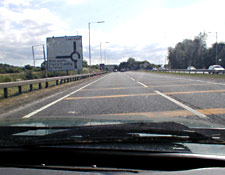
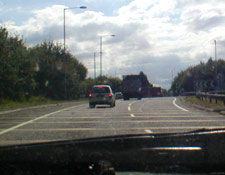
Progressively closer rumble strips on the A303 in Somerset.